|
|
 |
|
 |
|
BAGAN & ENVIRONS
Bagan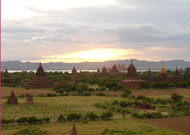 Bagan was ancient capital of the first Myanmar Empire,
founded by King Anawrahta. What is more, Anawrahta
accomplished another great task for the country: he
introduced Theravada Buddhism into Myanmar with the help of
Shin Arahan, a mission monk from THATON. It is one of the
richest archaeological sites in Southeast Asia. Bagan
preserves 2200 well-renovated Stupas, Pagodas and Temples
representing the diversity of ancient Myanmar architectural
styles in the 11th to13th centuries. Intricate frescoes or
mural paintings depicting the life of Buddha decorate the
interiors of the Pagodas and Stupas. Bagan has so many
mesmerising scenes that impress one's memory forever.
At BAGAN no monuments are the same. All are highly original in
design and conception. The structural techniques, similar to
the gothic form of Western Cathedral architecture, were in
advance of contemporary engineering in Europe.
Technologically daring in notion, and exquisite in
execution, the Temples of BAGAN are of a splendour rarely
witnessed anywhere else in the world.
HIGHLIGHTS
Ananda Temple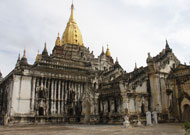
It
is one of the magnificent Temples of Bagan representing the
masterpiece of King Kyansittha and it crowns the early style
of Temple architecture of Bagan. Completed in 1091 the Anada
Temple resembles the perfect Greek Cross, with the arms
formed by porticoes radiating from a central square block.
There are four standing Buddha Statues in side facing each
cardinal points, and they are wonderfully illumined by light
filtering through the perforated windows above.
Shwezigon Pagoda
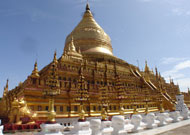 Built
in bell-shaped dome, Shwezigon is said to be the prototype
of later Myanmar Pagodas or Stupas. It is believed to be
enshrined frontlet bone, collarbone and tooth relic of
Buddha. Generally it is the most glorious Pagoda in Bagan
for Buddhist devotees. This Pagoda is related to the most
prominent Kings of Bagan era - Anawrahta (1044~1077) and
Kyansittha (1084~1113). It was constructed by the King
Anawrahta but only completed by King Kyansit since just the
three terraces was finished before the former king died.
Perhaps its golden mass gives you an impression of weight
and stability. Another interesting points is many souvenirs
shops located all along the stairways. Built
in bell-shaped dome, Shwezigon is said to be the prototype
of later Myanmar Pagodas or Stupas. It is believed to be
enshrined frontlet bone, collarbone and tooth relic of
Buddha. Generally it is the most glorious Pagoda in Bagan
for Buddhist devotees. This Pagoda is related to the most
prominent Kings of Bagan era - Anawrahta (1044~1077) and
Kyansittha (1084~1113). It was constructed by the King
Anawrahta but only completed by King Kyansit since just the
three terraces was finished before the former king died.
Perhaps its golden mass gives you an impression of weight
and stability. Another interesting points is many souvenirs
shops located all along the stairways.
Thatbyinnyu Temple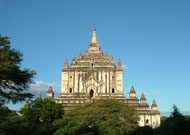
It
was built in the mid of 12 century. Rising up to 61 meters
Thatbyinnyu is the highest Temple of Bagan. Thatbyinnyu
represents the omniscience wisdom of the lord Buddha. It is
generally said in the third place of most significant
Pagodas of Bagan. Built by King Alaungsithu (113~1163), the
Thatbyin nyu is a transitional Temple between the early
style of the Anada and the late style of Gawdawpalin. To the
northeast of the Thatbyinnyu is the small "tally" temple. To
keep count of the bricks in the building of Thatbyinyu, one
brick was set aside for every 10,000 used, and this small
temple was built with the bricks thus set aside.
Tharabar Gate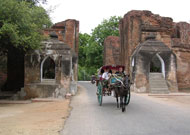
One
and only left out of 12 gates of the walled city of Bagan.
It is said to have been built around 9th century. In front
of the gate are two massive shrines house for two powerful
Nats, nickname in Mr. Cute and Ms. Golden Face. It is
normally the site overlooked by many a tourists and left as
a ruins after heavy earthquake took placed in 1975.
Gawdawpalin Temple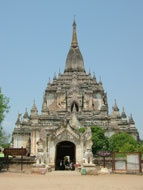
The
Gawdawpalin is a double-storied temple in the late style. It
is square in plan with four porticoes in each cardinal
points, but the eastern portico projecting further than the
others. It was left unfinished by King Narapatisithu and
completed by his son, King Htilomonlo (1211~1234), and
suffered by heavy earthquake of 1975 but has been repaired.
Mingalar Zedi Stupa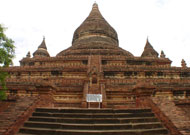
Located
on the main road to New Bagan, the Mingalar Zedi was built
in the last days of Bagan in 1284. It is an outstanding
representative of the Pagoda type whose form was established
by the Shwezigon. The three receding terraces, on which
octagonal base comes the bell-shaped dome and crowned by the
tapering conical finial - all these come together in a
pleasing and harmonious unity. This Pagoda is one of the
tourists' places to marvel the sunset of temples of Bagan
with the mighty Ayeyarwaddy River backdrop.
Bupaya Pagoda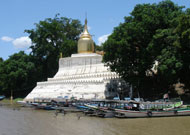
This
is the one of the earliest Pagodas of Bagan, and said to
have been built in 3rd century. Being located on a curve of
the Ayeyarwaddy, the Bupaya serves as a landmark for
travelers along the river. It is well-listed amongst the
highlight Temples or Pagodas of Bagan to enjoy sunset.
Htilominlo Temple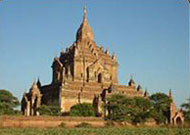
Built
in 1211, Htilominlo belongs to the late Temples style of
double storied monuments. It includes in the list of
highlight Pagodas that are worth of seeing. It is said to
have enshrined the Buddha's hair, and this two-storied
temple has four images of the Buddha in its ground storey.
Two stairways built into the thick walls lead to the upper
storey where there are another four images of Buddha.
Portions of the fine plaster carving still remain on the
arch pediments. Unfortunately the mural inside have suffered
by the passage of time.
Damayangyi Temple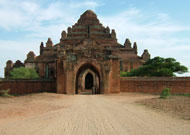
It
is built by King Narathu who ascended the throne after he
had killed his father. Later to compensate for his sin he
built a massive Temple which is noted for its fine
brickwork. The bricks are fitted so perfect that there is
hardly any space in between. The chronicles relate that its
builder, King Narathu (1163~1165) was killed by Indian
mercenaries sent by the then King of India Pateikkaya, after
whose daughter, Narathu's queen, had been killed by Narathu.
Thus he's got the nickname of "The King who was felled by
Indians".
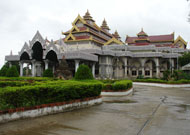 Archaeological Museum Archaeological Museum
Locate in the middle of old Bagan where you can observe the
history and ancient artifacts of glorious Bagan.
Mount
Popa is located 67km southeast of Bagan. It is an extinct
volcano rising 1518 meters high out of the plains. This
solitary peak is home of Myanmar's most powerful "NATS"- a
collection of 37 magical spirits both feared and honoured by
some Myanmar people. They still believe that nats can make
life difficult if they are not accorded sufficient respect.
Thousands of Myanmar gathers here twice yearly to honour the
spirits and attend the festivals (May/June). Mount Popa is
so lush and green that it is called the Oasis of the Dry
Zone. Mt. Popa is established as the National Park for
medicinal herbs, sandalwood plantation and reforestation
projects. It can be visited on a day trip from BAGAN or as a
brief stop en route to MANDALAY.
Although it's just a normal town between Prome and Bagan
Magway is the district where Myanmar independence architect
General Aung San belonged to.
Meikhtila is a junction town where you can bound for Mandalay,
Bagan or Inle Lake. Another highlight of the town is a war
cemetery of Japanese soldiers who died during world war II.
Pakokku lies in the west bank of Ayeyarwaddy crossing the
Nyaung Oo, Bagan. It is one of the major ports along the
Ayeyarwaddy River.
Thazi is another junction town bound for Bagn or Inle. If you
take the train from Yangon you need to change another leaves
for Inle Lake area. |
|
|
 |
|
 |
|